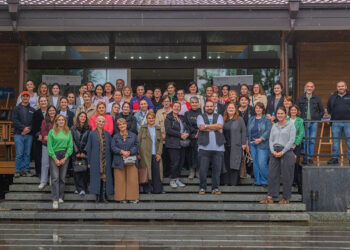A computable general equilibrium (CGE) model has been created by the International School of Economics at Tbilisi State University (ISET) Policy Institute, to analyze new potential free trade agreements (FTA) in Georgia.
According to Giorgi Papava, lead economist and lecturer at ISET, there are three countries they are focusing on for FTAs: India, South Korea, and the United States. Papava led a discussion about the model during a roundtable and explained the benefits it could bring to the country. CGE is designed to analyze economic change, and does so by measuring the change in value output of each sector, change in import/exports, change in real household income, impact on various taxes, and more.
During the roundtable, David Tarr, a former lead economist and ISET board member, explained that the CGE model would be funded by the World Bank, as it already is in other countries including Russia, Ukraine, and Kazakhstan. He said the reason and importance for having such a system is to fulfill the public awareness obligation of the government and to bring their attention to issues that need to be taken care of. This model focuses on integration elements and creates estimates that show the most gains, with whom, and which sector benefits and loses the most within Georgia.
The FTA with the US is a 0.59% welfare increase gain, a 0.13% welfare increase gain with India, and a 0.10% welfare increase gain with Korea
The model has already been created to analyze the current situation ongoing in the country. However, the experts say that if Georgia is accepted under European Union regulations, then there will be an additional impact for CGE. Acceptance will change the sectors that the machine will have to analyze, by requiring extra data and extensions, including Common External Tariff (CET), Emissions Trading System (ETS), migration, harmonization, government procurement, and elimination of antidumping actions between Georgia and the EU.
After the model was decided, they had to choose countries, Papava said. India and South Korea were already in the air, but the United States was added because of higher-level discussions. Papava says they will align FTA policies with the EU since one can be in place with a certain agreement, as seen by Azerbaijan and Turkey. He explained that there is no FTA with the US now, and progression toward that direction doesn’t seem close.

During the roundtable, data was compared of imports and exports of each sector between Georgia and the three countries, along with the Foreign Direct Investment (FDI) inflow of the countries. Papava listed potential policy scenarios with each country and what the outcome would look like.
“If we sign three FTAs, in the long run, we’d expect the trade balance to improve,” said Papava.
When analyzing the welfare gains from all three FTAs, there’s expected to be a 0.82% increase in total. The largest increase sector is Services: Reduction of Barriers Against Cross at a 0.31% increase from Georgia’s side. The FTA with the US is a 0.59% welfare increase gain, a 0.13% welfare increase gain with India, and a 0.10% welfare increase gain with Korea.
The largest positive impact of output by sectors would be in refined petroleum products, textile and clothing, and metal manufacturing
Papava explained that the impact of Georgia’s real gross domestic product (GDP) from the three FTAs would be a 0.25% increase. In nearly every FTA, services are the largest sector that is anticipated to have an increase. The CGE model will look at the macroeconomic impact for Georgia due to the FTAs, including aggregated impact real term, factor income real term, factor adjustments, and fiscal impacts.
The model indicates a total 0.53% increase in exports and a total 0.34% increase in imports from the three countries involved with FTA. Papava also noted that the largest positive impact of output by sectors would be refined petroleum products, textile and clothing, and metal manufacturing.
“The findings provide valuable insights for policymakers considering trade reforms, emphasizing the importance of deep preferential integration with the trading partners, as the decrease in non-tariff barriers for goods and the alleviation of barriers against FDI in Georgia are identified as major factors contributing significantly to improvements in welfare gains,” ISET notes on its website.
There are currently no requests or ties moving forward, so Papava and the others associated with ISET are looking forward to further discussion about the topic.
Also involved in speaking at the roundtable was Tamar Sulukhia, director of the ISET Policy Institute, and Veronika Movchan, with the Institute for Economic Research and Policy Consulting. Movchan talked about Ukraine’s CGE model, its 45 sectors, and trade barriers, including technical barriers, to trade in goods, time in trade costs for trade in goods, and barriers in trade in services.
“We hope this isn’t the end, but the beginning of implementing this model for the country’s benefit,” said Sulukhia.
By Shelbi R. Ankiewicz














